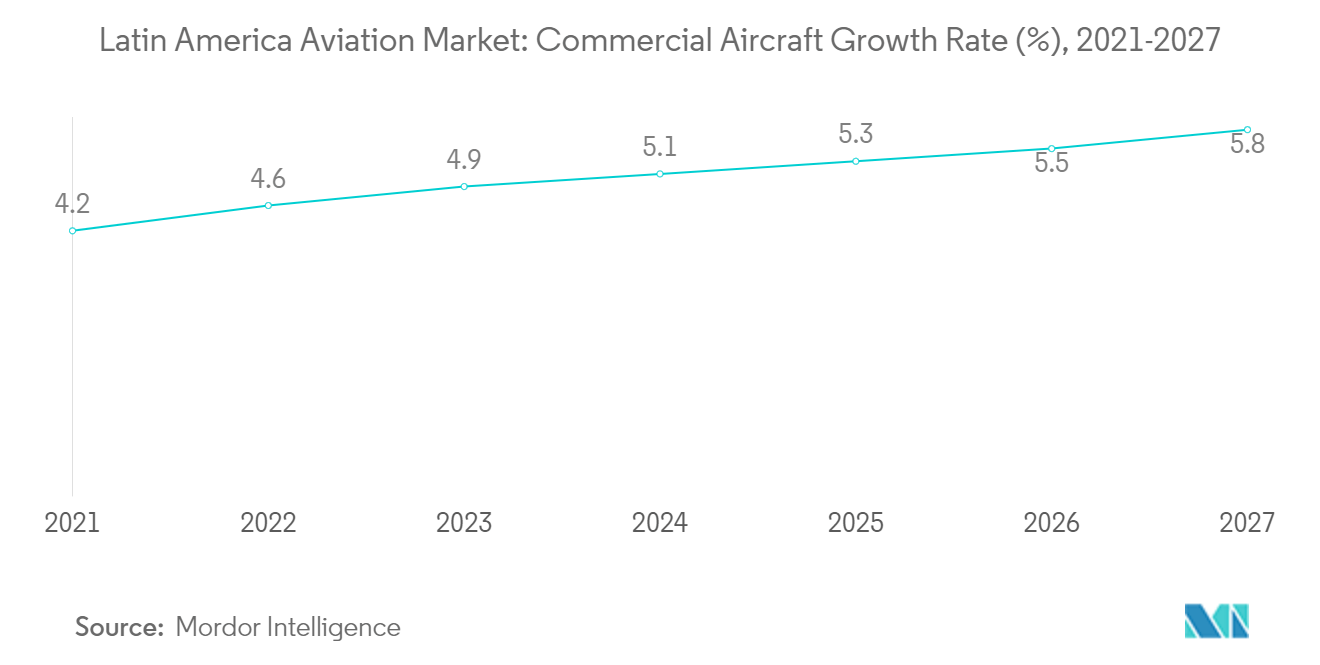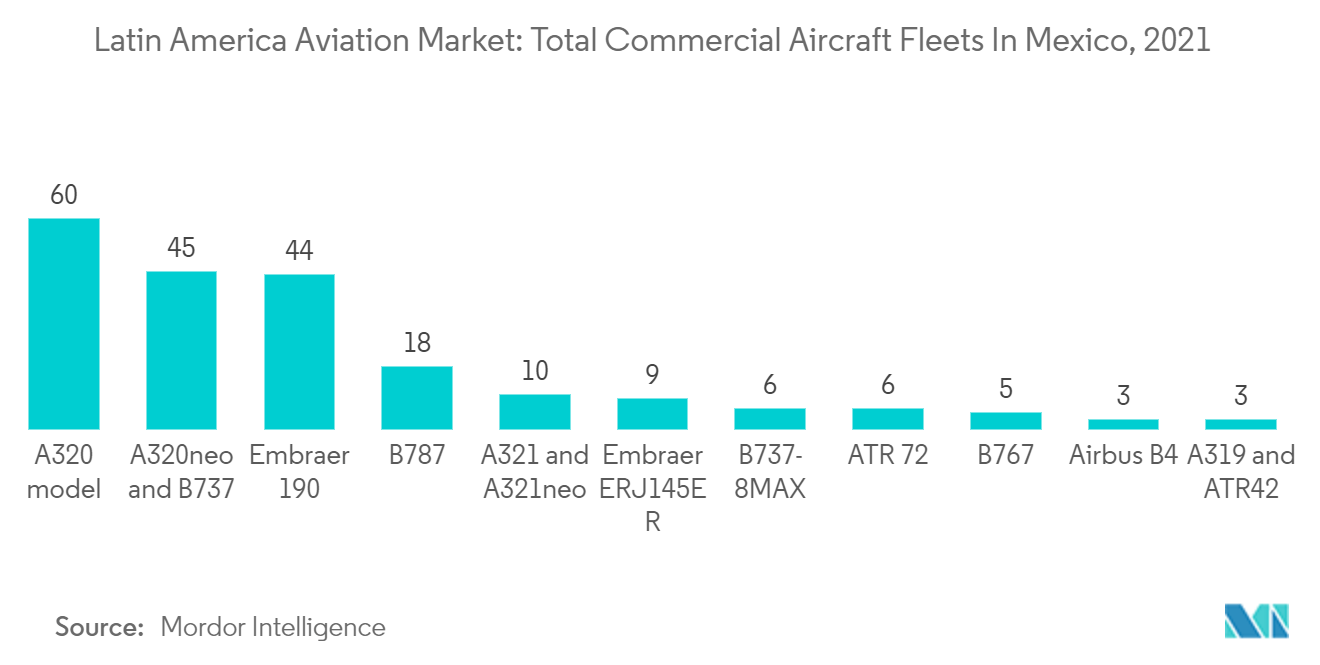Market Trends of Latin America Aviation Industry
This section covers the major market trends shaping the Latin America Aviation Market according to our research experts:
Commercial Aircraft Market is Expected to Have the Largest Market Share During the Forecast Period
The commercial aircraft market is expected to witness the largest market share in Latin American aviation. Increased aircraft deliveries and passenger traffic are expected to propel the market's growth in the coming years. In the past, airlines in Latin America, such as Colombia's SCADTA (now Avianca) and Brazil's VARIG, expanded their routes with Boeing aircraft. The growing aviation industry in Latin America increased the need for new aircraft. According to Airbus predictions, 2,550 new planes will be delivered in the Latin American region between 2022 and 2041. The new deliveries will lead to commercial airlines operating within Latin America witnessing significant growth in fleet size. They will notice an increase from the current 1450 aircraft, which are present in Latin America, to 2850 aircraft in the coming years.
Latin America is second to last in terms of projected deliveries for the next two decades, only above Africa, which expects to have 1,230 deliveries and 370 aircraft conversions. Around 81% of the fleet in Latin America is composed of narrowbody aircraft, and according to the predictions made by Airbus, nearly 92% of the deliveries consist of narrowbody jetliners. Moreover, narrow-body aircraft gained popularity in Latin American aviation due to the rise of low-cost carriers that deploy such aircraft to drive efficiencies and stimulate traffic.
In addition, the Boeing 737 MAX and Airbus A320neo family narrowbodies offer flight ranges for opening new, thinner routes between North America and Latin America, which were not plausible with older generations of aircraft. Airbus and Boeing are the leading original equipment manufacturers in the Latin American region and have large orders from key companies, such as LATAM, Avianca, Volaris, Aeromexico, and GOL. According to Airbus, it is still in a backlog of 465 aircraft to be delivered to the Latin American aviation industry. The Mexican ultra-low-cost carrier Volaris remains one of Airbus's leading clients, with an unfilled order of 122 aircraft yet to be delivered by Airbus. On the other hand, airline companies such as JetSMART, Avianca, and LATAM airlines group are also key clients for the European original equipment manufacturer, with Airbus having backlogs of 98, 88, and 69 unfilled orders, respectively for JetSMART, Avianca, and LATAM airlines group. Thus, the increase in rankings within Latin America will drive the market's growth in the coming years.

Mexico has the Largest Market Share in the Forecast Period
Mexico in the Latin America will have the largest market share during the forecast period. Before the COVID-19 pandemic, Mexico's aviation market witnessed steady growth despite many challenges. The development was driven by several factors, including the expansion of the low-cost carrier market and the conclusion of the US-Mexico 'Open Skies' agreement, which eliminated restrictions on routes between the two countries. Before the pandemic, Mexico's aviation market had eight notable passenger airlines, including Volaris, Grupo Aeromexico, Viva Aerobus, Interjet, Aeromar, Magnicharters, Transportes Aéreos Regionales, and Aéreo Calafia. Still, the onset of the pandemic led to a global halt in the aviation industry, which led to Mexico losing one of its main airlines, Interjet. Currently, the aviation industry in Mexico is dominated by two low-cost carriers, Volaris and VivaAerobus, and Mexico's sole full-service carrier Grupo Aeromexico. According to the data presented by the Federal Agency of Civil Aviation Mexico, 2021 was considered a growth year for low-cost airlines such as Volaris and VivaAerobos, and a recovery year for Grupo Aeromexico.
Additionally, these airlines are the main competitors in the Mexican aviation market, with all three carrying approximately 54 million passengers in 2021. On the other hand, airlines such as Aeromar, Magnicharters, Transportes Aéreos Regionales, and Aéreo Calafia are smaller competitors with niche markets and only operate within Mexico. According to the AFAC, the Federal Agency of Civil Aviation Mexico, these smaller airlines catered to the aviation industry by carrying 14 million passengers in 2021.
Since the pandemic began, Volaris has been consolidating its position as the country's leading domestic operator, with a market share of nearly 40%. This growth is attributed to the demise of Interjet and the financial difficulties which gripped Grupo Aeromexico. Moreover, compared to the rivals of Volaris, Grupo Aeromexico and VivaAerobus, the company managed the highest number of passengers carried for 2021, which amounted to 24.4 million with a growth of 11% compared to 2019. In addition, Volaris, in January 2022, had 2.3 million passengers, a gain of 21% compared to 2020.
Thus, the growing aviation market in Mexico and the increase in the number of air passenger traffic in recent times will propel the market's growth during the forecast period.

